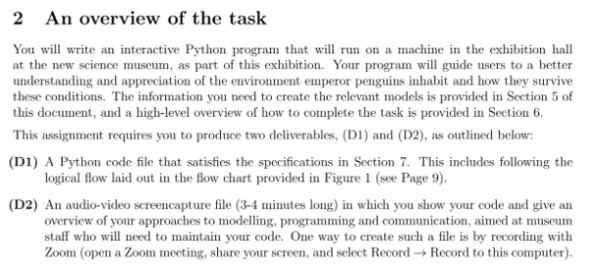Instructions
Objective
Write a python assignment program to create museum exhibition system.
Requirements and Specifications

Source Code
import math
import matplotlib.pyplot as plt
import numpy as np
# Declare the mean max and mean min temperatures per month
max_temp = [2.9, -1.6, -8.3, -11.1, -10.2, -12.5, -12.5, -10.8, -11.1, -8.3, -1.6, 1.8, 1.6]
min_temp = [-2.4, -7.4, -15.5, -17.2, -16.4, -18.4, -19.2, -17.6,-17.8, -14.5, -7.5, -4.5, -3.8]
def average_antarctic_temp(days):
"""
Calculates the average daily temperature (ºC) at that day
:param days: days since 1 Jan 2020
:return: Temperature in ºC
"""
# Given the day get the month id
month = int(days/30)
max_temp_month = max_temp[month]
min_temp_month = min_temp[month]
# Use a Quadratic function with a vertex (min point) at 1st July 2020, with a temperature of -19.2
# Note that, from 1 Jan 2020 to 1 July 2020, there are 180 days, so b = 180, c = -19.2
# We calculate a such that, at x = 366, the value of the function is equal to the max temperature
# The max. temperature is at x = 0, with a temperature of 2.9
c = -19.2
b = 180
a = (2.9 - c)/(0 - b)**2
y = a*(days - b)**2 + c
return y
def antarctic_temp(hours):
"""
Calculates the temperature at one specific time of the day
:param hours: Hours since midnight on 1 Jan 2020
:return: Temperature
"""
# We know that the sine function varies between -1 and 1. So, if we declare a sine function
# with an amplitude of 3, we obtain a function that varies between -3 and 3, so this will be used for the
# fluctuations of the temperature around the mean
# Calculate at wich month does the given hours are for
days = int(hours/24) # Number of days
month = int(days/30) # number of month
max_temp_month = max_temp[month]
min_temp_month = min_temp[month]
# Calculate mean temperature for this month
mean_temp = (max_temp_month + min_temp_month)/2.0
# Calculate the hours for this specific day
day_hours = hours - days*24
mean_temp = average_antarctic_temp(days)
# The sine function must have a period of 24 hours. Then:
y = mean_temp + math.sin(2*math.pi/24.0 *day_hours)
return y
def heat_transfer(Tair):
"""
Calculate the anticipated heat transfer through penguin's coat according to model in Section 5.3
:param Tair: Temperature of air (ºC)
:return: Heat (Wm^-2)
"""
# Define the Stefan-Boltzman constant
sigma = 5.670E-8
# Define emissivity
epsilon = 0.8
# Convert the air temperature to kelvin
Tair_K = Tair + 273.15
# Define the temperature on the Sea surface T2
T2 = -0.8
# Convert to Kelvin
T2_K = T2 + 273.15
# Calculate heat transfer
qr = sigma*(Tair_K**4 - T2_K**4)/(24 + (2/epsilon - 1))
return qr
def getMonth():
"""
This function will ask to user for a month and will check if the input is valid. If the input
is now valid, the function will display an error message and reprompt the user
:return: month
"""
while True:
try:
month = input("Enter a month (1-12): ")
month = int(month)
if month >= 1 and month <= 12:
return month-1
else:
print("Please enter a valid month.")
except:
print("Please enter a valid month.")
def getInt(lb = 0):
"""
This function will ask to user for a positive inteher and will check if the input is valid. If the input
is now valid, the function will display an error message and reprompt the user
:param lb: Lower bound for the value entered by the user
:return: integer
"""
while True:
try:
n = input("Enter value: ")
n = int(n)
if n > lb:
return n
else:
print("Please enter a valid number.")
except:
print("Please enter a valid number.")
def askYesNo(message):
"""
This function will prompt the user to enter "yes" or "no". If the user enters an invalid answer, the function
will reprompt the user
:return: option entered by user as string in lower case
"""
while True:
option = input(message).lower()
if option in ["yes", "no"]:
return option
else:
print("Please enter a valid option.")
# Main program
if __name__ == '__main__':
# Print welcome message
print("Welcome!")
print('''
The Emperor Penguin (Aptenodytes forsteri) is the tallest and heaviest of all living penguin species and is endemic to Antarctica.\n
They usually live in seas with a temperature of -0.8 ºC and have a total of 14 humeral arterioes. The surface area for their wings is about 202 cm^2
''')
print('''
The antarctic temperatures are very low and for 2020, these temperatures varied between 2.9 ºC and -19.2 ºC
''')
while True:
month = getMonth()
# Convert the given month to hours since 1 Jan 2020
hours = month*24*30
# Calculate the temperatures over the month
temps = [antarctic_temp(i) for i in range(hours, hours+24*25)]
print(f"The daily average temperature (ºC) for month {month} are:")
print("{:<10s} {:>20s}".format("Day", "Temperature (ºC)"))
for i in range(30):
T = average_antarctic_temp((month-1)*30+i)
print("{:<10d} {:>20.2f}".format(i+1, T))
# Ask user if he/she is an "enthusiast"
option = askYesNo("Are you an enthusiast? (yes/no): ")
if option == "yes":
# Plot
plt.figure()
plt.plot(range(24*25), temps)
plt.grid(True)
plt.title(f"Temperature fluctuations for month {month+1}")
plt.xlabel('Hours')
plt.ylabel('Temperature (ºC)')
plt.show()
# Prompt for time of the day
print("Please enter a time of the day, in hours (1-24): ")
hour = getInt()
Tcalc = antarctic_temp((month-1)*30*24+hour)
print("The temperature (in ºC) at month {:.0f} at the hour {:.1f} is: {:.2f} ºC".format(month, hour, Tcalc))
# Display importance of feathers
print('''
The feathers in the Emperor Penguins are very important because they help to transfer the heat from the Penguin's body to the exterior
''')
print("Please enter the temperature of the air (in ºC): ")
Tair = getInt(-273.15)
# Calculate heat transfer
qr = heat_transfer(Tair)
print("The heat transfer between the Penguin's body and the exterior is: {0:.2f} Wm^-2".format(qr))
# Ask user if he/she wants to chose another month
option = askYesNo("Do you want to chose another month? (yes/no): ")
if option == "no":
break
print('''
Penguins keep their non-feathered extremities warm thanks to the humeral arteries and the surface area of their wings.
''')
option = askYesNo("Are you an enthusiast? (yes/no): ")
if option == "yes":
# Data of humeral arterioes vs wing surface area
arteries = [2, 3, 3, 3, 5, 8, 14]
area = [30, 68, 80, 82, 75, 159, 202]
sea_temp = [14.9, 11.6, 10.0, 8.7, -0.8, 3.3, -0.8]
# Fit
z = np.polyfit(arteries, area, 3)
p = np.poly1d(z)
y_fit = [p(i) for i in arteries]
plt.figure()
plt.scatter(arteries, area, label = "Data")
plt.plot(arteries, y_fit, label="Fit", color='red')
plt.xlabel('Number of Humeral Arteries')
plt.ylabel('Wing surface area (cm^2)')
plt.grid(True)
plt.legend()
plt.title("Wing Surface Area vs. Number of Humeral Arteries")
plt.show()
# Now fit model for sea temp
z2 = np.polyfit(arteries, sea_temp, 3)
p2 = np.poly1d(z2)
y_fit2 = [p2(i) for i in arteries]
plt.figure()
plt.scatter(arteries, sea_temp, label="Data")
plt.plot(arteries, y_fit2, label="Fit", color='red')
plt.xlabel('Number of Humeral Arteries')
plt.ylabel('Temperature at surface of the Sea (ºC)')
plt.grid(True)
plt.legend()
plt.title("Sea Tempterature vs. Number of Humeral Arteries")
plt.show()
print("Good Bye!")
unction accepts two lists of integers, and count how many numbers from the second list
are in the first list
:param winning_numbers: list of integers
:param numbers: list of integers
:return: number of matched integers (int)
"""
matches = 0
for n in numbers:
if n in winning_numbers:
matches += 1
return matches
def main():
"""
Main function where all the functionality of the program is contained
:return: None
"""
# First, pick today's winning numbers
winning_numbers = pick_winning_numbers(1, 9, 4)
# Pick the superball number
sb = pick_superball(1, 9)
# Create helper variables to count the number of entries, number of entries that used superball,
# number of entries that matched 3 or 4 numbers, etc
n_entries = 0
n_superball_used = 0
n_matched_3 = 0
n_matched_4 = 0
# Now, read the file of entries
with open("entries.txt", 'r') as f:
# Read all lines
lines = f.readlines()
# Pick customer numbers
for i, line in enumerate(lines):
# trim and strip line
line = line.strip()
# Split line by space to convert it into a list
customer_numbers_str = line.split(" ")
# Check if this customer used superball
user_used_sb = False
if "sb" in customer_numbers_str:
# Remove the 'sb' from customer's numbers
user_used_sb = True
del customer_numbers_str[customer_numbers_str.index("sb")]
# Increment the counter for number of superball used
n_superball_used += 1
# Now, convert customer's numbers from string to int
customer_numbers = convert_list_to_integers(customer_numbers_str)
# Now, count matches
n = count_matches(winning_numbers, customer_numbers)
"""
Now, if the user used the 'sb' option:
* If the 'sb' number is in today's winning numbers, then add one additional match
to this user
* If 'sb' is not in today's winning numbers, then check if the user has this number
"""
if sb in winning_numbers:
n += 1
else:
if sb in customer_numbers and not sb in winning_numbers:
n += 1
# Increment the entries counter
n_entries += 1
# Check if the number of matches is 3 or 4
if n == 3:
n_matched_3 += 1
elif n == 4:
n_matched_4 += 1
# Now, display the results
print("Pythonic Pick 4 Lottery Results")
print("Today's winning numbers: [", end="")
for i, x in enumerate(winning_numbers):
print(x, end="")
if i < len(winning_numbers) -1:
print(", ", end="")
print("]")
print(f"Today's superball: {sb}")
print(f"Number of entries: {n_entries}")
print(f"Number of entries that used superball: {n_superball_used}")
print(f"Number of entries that matched 3 numbers: {n_matched_3}")
print(f"Number of entries that matched 4 numbers: {n_matched_4}")
if __name__ == '__main__':
main()
Related Samples
At ProgrammingHomeworkHelp.com, we provide exceptional support for Python assignments through a diverse collection of related samples. Our Python samples are expertly designed to help students understand and apply key programming concepts, such as data manipulation, algorithms, and object-oriented principles. Each sample is crafted to clarify complex topics and offer practical solutions, making it easier for you to tackle your assignments. Whether you're a beginner or working on advanced projects, our resources will guide you every step of the way. Discover our Python samples today and enhance your programming skills with confidence.
Python
Python
Python
Python
Python
Python
Python
Python
Python
Python
Python
Python
Python
Python
Python
Python
Python
Python
Python
Python
